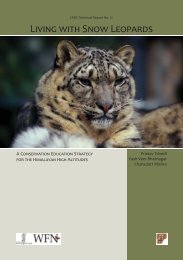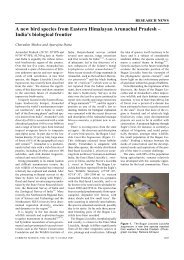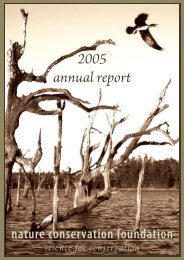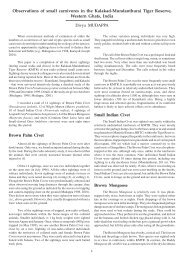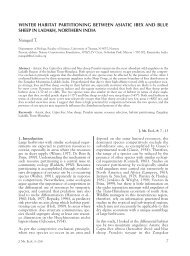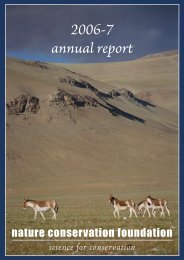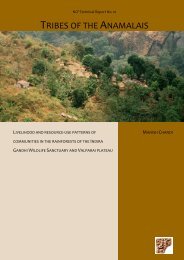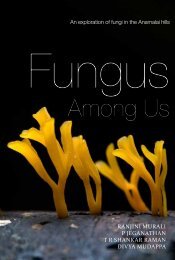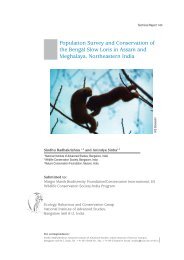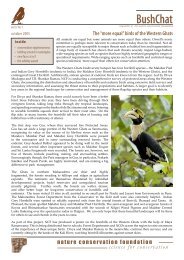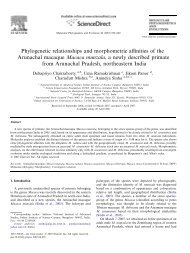Joshi Mudappa Raman - Nature Conservation Foundation
Joshi Mudappa Raman - Nature Conservation Foundation
Joshi Mudappa Raman - Nature Conservation Foundation
You also want an ePaper? Increase the reach of your titles
YUMPU automatically turns print PDFs into web optimized ePapers that Google loves.
2388 A. A. <strong>Joshi</strong> et al.<br />
amount of edge following fragmentation, in particular,<br />
may negatively affect many mature forest species and<br />
ecological processes. Studies have shown that the<br />
artificial edges created by forest fragmentation create<br />
favourable conditions for the appearance of invasive<br />
alien species (Denslow et al. 2001; Fine 2002).<br />
According to the World <strong>Conservation</strong> Union (IUCN),<br />
the potential damage by invasive species to native<br />
species and ecosystems on a global scale is considered<br />
as important as the impact due to habitat degradation<br />
making it a serious conservation issue (IUCN 2000;<br />
Soulé and Orians 2001).<br />
Earlier studies have shown significant changes in<br />
biological diversity and increased prevalence of<br />
invasive species at or near forest fragment edges<br />
(Saunders et al. 1991; Sisk and Margules 1993). This<br />
may be linked to disturbance and edge-related microclimatic<br />
changes such as increase in temperature and<br />
light and reduction in humidity in fragments (Saunders<br />
et al. 1991; Laurance 2000). In addition, variables of<br />
forest structure and surrounding landscape matrix may<br />
also influence the distribution of non-indigenous<br />
species (Whitmore 1997; Denslow et al. 2001). Within<br />
fragments, disturbances such as canopy openings and<br />
changes to the soil surface may also enhance the<br />
likelihood of establishment of light-demanding or<br />
disturbance-adapted invasive alien species (Whitmore<br />
1997; Denslow et al. 2001; McNeely et al. 2001).<br />
The rainforests in the Western Ghats of India, a hill<br />
range recognised as a global biodiversity hotspot<br />
(Mittermeier et al. 2004), face threats similar to those<br />
faced by tropical forests in other parts of the world.<br />
Much of the Western Ghats rainforests now exists as<br />
fragments surrounded by plantations, mostly of nonindigenous<br />
plant species such as coffee (Coffea spp.),<br />
Eucalyptus, and tea (Kumar et al. 2004). Studies in one<br />
such fragmented landscape, the Valparai plateau in the<br />
Anamalai hills, have indicated the occurrence of nonindigenous<br />
species in many rainforest fragments<br />
(Muthuramkumar et al. 2006; <strong>Mudappa</strong> and <strong>Raman</strong><br />
2007). These include two species of coffee (Arabica<br />
Coffea arabica and Robusta C. canephora) that are<br />
shade-tolerant tropical understorey crops, Maesopsis<br />
eminii, an African tree species used as shade tree in<br />
coffee plantations, and other understorey weeds common<br />
in tropical south and south-east Asia such as<br />
Lantana camara and Chromolaena odorata.<br />
The need to assess coffee as a potential invasive in<br />
tropical forests becomes significant because, globally,<br />
123<br />
around 11 million hectares are under coffee cultivation,<br />
almost entirely in tropical forest regions (Clay 2004).<br />
With an annual value of over $100 billion, coffee is<br />
also the second highest traded commodity in international<br />
trade after oil, making assessment of its impacts<br />
on biodiversity an imperative (Donald 2004). Clearing<br />
new areas of tropical forest for coffee cultivation has<br />
also been a matter of recent conservation concern<br />
(Rappole et al. 2003). Frequently, coffee plantations<br />
adjoin protected conservation reserves or contain<br />
embedded forest remnants known to be significant for<br />
conservation of biological diversity (Somarriba et al.<br />
2004). Considerable recent research has addressed the<br />
biodiversity values of coffee plantations, especially<br />
shade-grown coffees (Rappole et al. 2003; Mas and<br />
Dietsch 2004), and the economic benefits of biodiversity<br />
to coffee farms (Ricketts et al. 2004;Philpottetal.<br />
2007). However, little attention has been paid on the<br />
effects of coffee plantations on adjoining tropical<br />
forests. A study in New South Wales has reported the<br />
spread of coffee (C. arabica) as a weed inside<br />
rainforest fragments and noted its potential threat to<br />
rainforest regeneration (Lymburner et al. 2006).<br />
This study was designed to assess the distribution<br />
and abundance of coffee species in relation to the<br />
distance from fragment edges and forest structural<br />
variables in tropical rainforest fragments on the<br />
Valparai plateau. We also compared the patterns of<br />
distribution and abundance of the two major coffee<br />
species, C. arabica and C. canephora. The results are<br />
discussed in the context of the potential for a widelycultivated<br />
crop to spread as an invasive and thereby<br />
affect tropical forest conservation.<br />
Materials and methods<br />
Study area<br />
The Western Ghats is a chain of mountains running<br />
almost parallel to the west coast of India from 7° to<br />
21° N. The 1600 km stretch is interrupted only by the<br />
30 km wide Palghat gap (11° N). High levels of<br />
biodiversity and endemism are its prominent characteristics,<br />
with about 5,000 flowering plant species, of<br />
which 1,700 species are endemic (Kumar et al. 2004).<br />
The forests of the Western Ghats include representative<br />
non-equatorial tropical wet evergreen forests of<br />
high conservation priority (Menon et al. 2001). This



